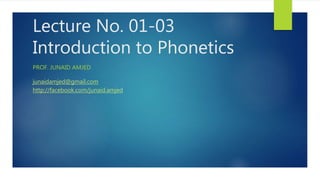This document provides an introduction to phonetics. It defines linguistics as the scientific study of language and notes that phonetics is the study of speech sounds. The document outlines the main branches of linguistics and focuses on articulatory phonetics. It describes the key organs involved in speech production, including the larynx, vocal cords, nasal cavity, oral cavity, lips, teeth, alveolar ridge, hard palate, soft palate, tongue, uvula and glottis. Examples are given of sounds produced using different articulators.



















